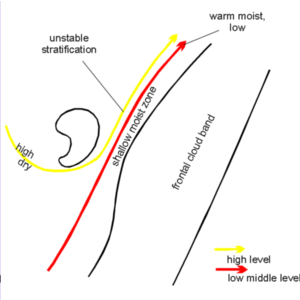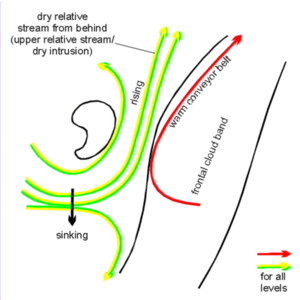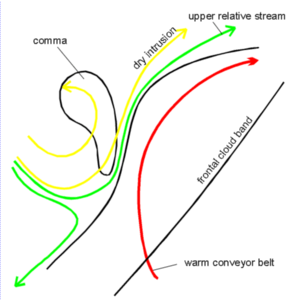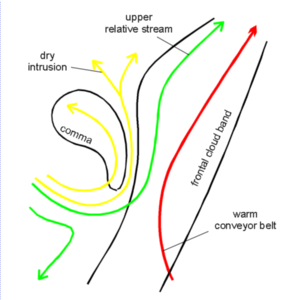Instant Occlusion - Meteorological Physical Background
by ZAMG and FMI
The Cold Front is connected with a large upper trough. In this trough there is a smaller secondary trough moving faster than the large trough. In the secondary trough there is convective cloud development, a Comma. The development involves the expansion of a cloud cluster into a baroclinic leaf with cyclonic rotation.
Because the smaller trough is moving faster than the large one, Comma overtakes the frontal cloudiness and the two cloud systems merge. Often there is simultaneously going on a wave development within the polar front. The result is a cloud system that resembles an occlusion, but without the actual occlusion process. If the Comma merges with the frontal cloudiness in the area of a Wave, the Occlusion-like feature is very pronounced.
Initial (pre-merging) stage:
- A Cold Front is associated with an eastward moving upper trough.
- In the cold air mass behind the Cold Front, but clearly separated from it, there is a Comma cloud related to a small, sharp trough moving along the edge of the large trough (see Key Parameters).
- There is weak baroclinity related to the Comma; as the cyclonic motion increases, regions of warm and cold advection form ahead and behind the Comma, respectively (see Key Parameters).
Merging stage:
- Positive vorticity advection and warm advection associated to the Comma produce upward motion. This leads to a rapid cloud development, and as the two cloud features simultaneously get nearer each other, they merge.
- The warm advection ahead of the Comma creates a short nook in the temperature field of the frontal zone, but it is remarkably smaller than the ridge that is formed in an occlusion leading to the typical appearance of an occlusion cloud spiral (see Key Parameters).
Discussion: The relative stream point of view
The Initial Stage:Within and ahead of the Comma an ascending stream of warm and moist air is orientated from southern to northern directions in lower layers. Within the middle and upper levels of the troposphere, dry air moves around the upper level trough overrunning the Comma tail and turning to northern directions parallel to the rear cloud edge of the Cold Front. The vertical stratification of relative stream with warm, moist air and dry air above causes a potential unstable stratification in the shallow moist zone between the two cloud features.

|

|
The Merging Stage:
The potential unstable stratification within the area of the shallow moist zone will now be released due to the developing ascending motion. The ascending motion is caused by the combination of WA and PVA which contributes to upward motion; in particular WA is connected with the Wave feature at the Cold Front. As a consequence of this process rapid cloud development can be observed in the shallow moist zone. Due to WA ahead of the Comma a thermal gradient is generated on its northern side.

|

|
- A low level dry outflow from eastern directions appears
- The wet low level stream from south-west no longer exists
- A rising warm conveyor belt accompanying the frontal cloud band
- A relative stream from behind strongly rising in the area of the front and the Comma in accordance with the area of cloud development
- A splitting of the relative stream from behind close to the Wave point
Final Stage:
In the end of the development the cloud configuration may resemble Cold Conveyor Belt occlusion (see Occlusion: Cold Conveyor Belt Type ), or the part of the cloudiness that resembles an occluded front, can dissolve.
The case studies, however, have shown that the relative stream structure described above can not always be found. More investigations with high resolution model would be needed.


